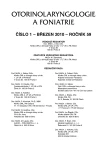The Contribution of Binaural Amplification to Speech Intelligibility – Effect of the Previous Adaptation to Monaural Amplification
Authors:
R. Havlík
Authors‘ workplace:
AUDIO-Fon centr, s. r. o., Brno
přednosta doc. MUDr. M. Lejska, CSc.
Published in:
Otorinolaryngol Foniatr, 59, 2010, No. 1, pp. 3-6.
Category:
Original Article
Overview
The paper describes the analysis of quantitative contribution of binaural amplification in contrast to monaural one in persons with primary application of hearing aid on both ears as compared with persons after long-term adaptation to monaural amplification, specifically in precisely defined signal-to-noise ratios (SNR). Consequently, 83 persons (right-handed) adapted for at least 5 years to monaural use of the hearing aid on the right ear and 106 first-users of binaural amplification, who have had no experience with the hearing aid before, have been examined. The results indicate that the contribution of the hearing aid on the other ear in symmetrical hearing loss was statistically comparable in both groups.
Key words:
monaural, amplification, acoustic information, frequency analysis, digital hearing aid.
Sources
1. Brugel, F. J., Schorn, K.: Die In-situ-Messung als Notwendiger Bestandteil der Hörgeräteanpassung. Laryngorhinootologie, 70, 1991, 11, s. 616-619.
2. Brugel, F. J., Schorn, K., Fastl, H.: Eie Einfluss der Zusatzbohrung im Ohrpassstück auf die Sprachdiscrimination im Störgeräuch. HNO, 39, 1991, 9, s. 356-361.
3. Burkey, J. M., Arkis, P. N.: Word recognition changes after monaural, binaural amplification. Hear Instrum., 44, 1993, 1, s. 8-.
4. Gatehouse, S.: Apparent auditory deprivation effects: The role of presentation level. J. Acoust. Soc. Am., 86, 1989, s. 2103-2106.
5. Havlík, R.: Vliv individuální ušní vložky na akustický signál sluchadla. Philips, 1998.
6. Havlík, R.: Sluchadlová propedeutika. MIKADAPRESS, Brno, 2007.
7. Irvine, D. R. F., Fallon, J. B., Kamke, M. R.: Plasticity in the adult central auditory system. Acoust., 34, 2006, 1, s. 13-17.
8. Keller, F., Freiburg, B.: Akustische Eigenschaften des Ohrpassstückes. Zusammenstellung, 1982.
9. Phillips, D. P., Hall, S. E.: Psychophysical evidence for adaptation of central auditory processors for interaural differences in time and level. Hearing research, 202, 2005, 1-2, s. 188-189.
10. Sandlin, R. E. Texbook of hearing aid amplification - technical and clinical considerations. Singular Publishing Group, Thomson Learning, San Diego, 2000.
11. Silman, S., Gelfand, S. A., Silverman, C. A.: Late-onset auditory deprivation: Effects of monaural versus binaural hearing aids. J. Acoust. Soc. Am., 76, 1984, s. 1357-1362.
12. Silverman, C. A.: Auditory deprivation. Hear Instrum., 40, 1989, 9, s. 26-32.
13. Silverman, C. A., Silman, S: Apparent auditory deprivation from monaural amplification and recovery from binaural amplification: Two case studies. J. Am. Acad. Audio., 1990, 1, s. 175-180.
14. Stubblefield, J., Nye, C.: Aided and unaided time-related differences in word discrimination. Hear Instrum., 40, 1989, 9, s. 38-39, 42-43, 78.
15. Webster, D. B., Webster, M.: Neonatal sound deprivation affect brainstem auditory nuclei. Arch. Otolaryngol., 103, 1977, s. 392-396.
16. Wotton, J. M., Ferragamo, M. J., Halvorson, K.: BMC. Neuroscience, 2008, 9 (suppl. 1), s. 114.
Labels
Audiology Paediatric ENT ENT (Otorhinolaryngology)Article was published in
Otorhinolaryngology and Phoniatrics

2010 Issue 1
Most read in this issue
- Reflux Finding Score
- Importance of Neck Nodes Dissection in the Organ Preserving Protocol
- Late Results of Cholesteatoma Surgery in Children
- Bipolar Coagulation BiClamp® in the Operation on Thyroid Gland
